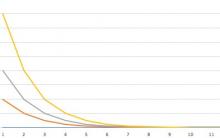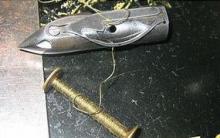- The unit of pressure in SI-pascal (Russian designation: Pa; international: Pa) \u003d N / m 2
- Conversion table for pressure units. Pa; MPa; bar; atm; mmHg.; mm w.st.; m w.st., kg / cm 2; psf; psi inches Hg; in.st. below
- Note, there are 2 tables and a list. Here's another useful link:
| In units: | ||||||||
| Pa (N / m 2) | MPa | bar | atmosphere | mmHg Art. | mm w.st. | m w.st. | kgf / cm 2 | |
| Should be multiplied by: | ||||||||
| Pa (N / m 2) - pascal, SI unit of pressure | 1 | 1*10 -6 | 10 -5 | 9.87*10 -6 | 0.0075 | 0.1 | 10 -4 | 1.02*10 -5 |
| MPa, megapascal | 1*10 6 | 1 | 10 | 9.87 | 7.5*10 3 | 10 5 | 10 2 | 10.2 |
| bar | 10 5 | 10 -1 | 1 | 0.987 | 750 | 1.0197*10 4 | 10.197 | 1.0197 |
| atm, atmosphere | 1.01*10 5 | 1.01* 10 -1 | 1.013 | 1 | 759.9 | 10332 | 10.332 | 1.03 |
| mmHg Art., mmHg | 133.3 | 133.3*10 -6 | 1.33*10 -3 | 1.32*10 -3 | 1 | 13.3 | 0.013 | 1.36*10 -3 |
| mm w.st., mm water column | 10 | 10 -5 | 0.000097 | 9.87*10 -5 | 0.075 | 1 | 0.001 | 1.02*10 -4 |
| m w.st., meter of water column | 10 4 | 10 -2 | 0.097 | 9.87*10 -2 | 75 | 1000 | 1 | 0.102 |
| kgf / cm 2, kilogram-force per square centimeter | 9.8*10 4 | 9.8*10 -2 | 0.98 | 0.97 | 735 | 10000 | 10 | 1 |
| 47.8 | 4.78*10 -5 | 4.78*10 -4 | 4.72*10 -4 | 0.36 | 4.78 | 4.78 10 -3 | 4.88*10 -4 | |
| 6894.76 | 6.89476*10 -3 | 0.069 | 0.068 | 51.7 | 689.7 | 0.690 | 0.07 | |
| Inches Hg / inches Hg | 3377 | 3.377*10 -3 | 0.0338 | 0.033 | 25.33 | 337.7 | 0.337 | 0.034 |
| inches w.st. / inchesH2O | 248.8 | 2.488*10 -2 | 2.49*10 -3 | 2.46*10 -3 | 1.87 | 24.88 | 0.0249 | 0.0025 |
| To convert pressure in units: | In units: | |||
| pounds per sq. pound square feet (psf) | pounds per sq. inch / pound square inches (psi) | Inches Hg / inches Hg | inches w.st. / inchesH2O | |
| Should be multiplied by: | ||||
| Pa (N / m 2) - SI unit of pressure | 0.021 | 1.450326*10 -4 | 2.96*10 -4 | 4.02*10 -3 |
| MPa | 2.1*10 4 | 1.450326*10 2 | 2.96*10 2 | 4.02*10 3 |
| bar | 2090 | 14.50 | 29.61 | 402 |
| atm | 2117.5 | 14.69 | 29.92 | 407 |
| mmHg Art. | 2.79 | 0.019 | 0.039 | 0.54 |
| mm w.st. | 0.209 | 1.45*10 -3 | 2.96*10 -3 | 0.04 |
| m w.st. | 209 | 1.45 | 2.96 | 40.2 |
| kgf / cm 2 | 2049 | 14.21 | 29.03 | 394 |
| pounds per sq. pound square feet (psf) | 1 | 0.0069 | 0.014 | 0.19 |
| pounds per sq. inch / pound square inches (psi) | 144 | 1 | 2.04 | 27.7 |
| Inches Hg / inches Hg | 70.6 | 0.49 | 1 | 13.57 |
| inches w.st. / inchesH2O | 5.2 | 0.036 | 0.074 | 1 |
Detailed list of pressure units, one pascal is:
- 1 Pa (N / m 2) \u003d 0.0000102 Atmosphere "metric" / Atmosphere (metric)
- 1 Pa (N/m 2) = 0.0000099 Atmosphere (standard) = Standard atmosphere
- 1 Pa (N / m 2) \u003d 0.00001 Bar / Bar
- 1 Pa (N / m 2) \u003d 10 Barad / Barad
- 1 Pa (N / m 2) \u003d 0.0007501 Centimeters of mercury. Art. (0°C)
- 1 Pa (N / m 2) \u003d 0.0101974 Centimeters in. Art. (4°C)
- 1 Pa (N / m 2) \u003d 10 dyne / square centimeter
- 1 Pa (N/m 2) = 0.0003346 Foot of water / Foot of water (4 °C)
- 1 Pa (N / m 2) \u003d 10 -9 Gigapascals
- 1 Pa (N / m 2) \u003d 0.01
- 1 Pa (N / m 2) \u003d 0.0002953 Dumov Hg / Inch of mercury (0 °C)
- 1 Pa (N / m 2) \u003d 0.0002961 Inches of mercury. Art. / Inch of mercury (15.56 °C)
- 1 Pa (N / m 2) \u003d 0.0040186 Dumov w.st. / Inch of water (15.56 °C)
- 1 Pa (N / m 2) \u003d 0.0040147 Dumov w.st. / Inch of water (4 °C)
- 1 Pa (N / m 2) \u003d 0.0000102 kgf / cm 2 / Kilogram force / centimetre 2
- 1 Pa (N / m 2) \u003d 0.0010197 kgf / dm 2 / Kilogram force / decimetre 2
- 1 Pa (N / m 2) \u003d 0.101972 kgf / m 2 / Kilogram force / meter 2
- 1 Pa (N / m 2) \u003d 10 -7 kgf / mm 2 / Kilogram force / millimeter 2
- 1 Pa (N / m 2) \u003d 10 -3 kPa
- 1 Pa (N / m 2) \u003d 10 -7 Kilopound force / square inch / Kilopound force / square inch
- 1 Pa (N / m 2) \u003d 10 -6 MPa
- 1 Pa (N / m 2) \u003d 0.000102 Meters w.st. / Meter of water (4 °C)
- 1 Pa (N / m 2) \u003d 10 Microbar / Microbar (barye, barrie)
- 1 Pa (N / m 2) \u003d 7.50062 Microns of mercury / Micron of mercury (millitorr)
- 1 Pa (N / m 2) \u003d 0.01 Milibar / Millibar
- 1 Pa (N/m 2) = 0.0075006 (0 °C)
- 1 Pa (N / m 2) \u003d 0.10207 Millimeters of w.st. / Millimeter of water (15.56 °C)
- 1 Pa (N / m 2) \u003d 0.10197 Millimeters w.st. / Millimeter of water (4 °C)
- 1 Pa (N / m 2) \u003d 7.5006 Millitorr / Millitorr
- 1 Pa (N/m2) = 1N/m2 / Newton/square meter
- 1 Pa (N / m 2) \u003d 32.1507 Daily ounces / sq. inch / Ounce force (avdp)/square inch
- 1 Pa (N / m 2) \u003d 0.0208854 Pounds of force per sq. foot / Pound force/square foot
- 1 Pa (N / m 2) \u003d 0.000145 Pounds of force per sq. inch / Pound force/square inch
- 1 Pa (N / m 2) \u003d 0.671969 Poundals per sq. foot / Poundal/square foot
- 1 Pa (N / m 2) \u003d 0.0046665 Poundals per sq. inch / Poundal/square inch
- 1 Pa (N / m 2) \u003d 0.0000093 Long tons per sq. foot / Ton (long)/foot 2
- 1 Pa (N / m 2) \u003d 10 -7 Long tons per sq. inch / Ton(long)/inch 2
- 1 Pa (N / m 2) \u003d 0.0000104 Short tons per sq. foot / Ton (short)/foot 2
- 1 Pa (N / m 2) \u003d 10 -7 Tons per sq. inch / Ton/inch 2
- 1 Pa (N / m 2) \u003d 0.0075006 Torr / Torr
- pressure in pascals and atmospheres, convert pressure to pascals
- atmospheric pressure is equal to XXX mm Hg. express it in pascals
- gas pressure units - translation
- liquid pressure units - translation
It is quite easy for an uninitiated person to get confused in the abundance of pressure units that exist today, exacerbated by the use of relative and absolute scales. Therefore, we considered it necessary to give here, in addition to the table of correspondences, several definitions and practical advice, which, in our opinion, should help an inexperienced customer to correctly determine the choice of the pump or compressor he needs.
First of all, let's deal with absolute and relative pressure.
Absolute pressure is the pressure measured relative to absolute zero pressure, or, in other words, absolute vacuum.
Relative pressure (in compressor technology, excess) is the pressure measured relative to the earth's atmosphere.
That is, if we use kgf / cm² (technical atmospheres) as the unit of measurement, then absolute vacuum will correspond to zero on the absolute scale and minus one on the relative scale, while atmospheric pressure will correspond to one on the absolute scale and zero on the relative scale. For compressors, everything is simpler - the excess pressure will always be 1 atmosphere less than the absolute one.
The values of the maximum residual pressures of pumps on our website are given for the most part in absolute millibars, since it is this pressure unit that is most widely used among Western manufacturers of vacuum equipment. But since in the territory former USSR very often Bourdon tubes are used as vacuum gauges, showing the relative pressure in technical atmospheres (at. or kgf / cm²), most often our customers are faced with the need to convert relative technical atmospheres into absolute millibars and vice versa. To do this, use the formula:
To convert millibars to Torr (mm Hg) or Pascals, remember the ratio:
1 millibar=100Pa=0.75 mm. rt. Art.
Table of relationships between the main units of pressure measurement:
| Unit | Translate to | Coefficient |
|---|---|---|
| bar | 0,980665 | |
| 1 kilogram force per centimeter 2 (kgf/cm 2) | MPa | 0,0980665 |
| 1 kilogram force per centimeter 2 (kgf/cm 2) | kPa | 98,0665 |
| 1 kilogram force per centimeter 2 (kgf/cm 2) | PSI | 14,22334 |
| 1 psi | kgf/cm2 | 0,07030696 |
| 1 psi | bar | 0,06894757 |
| 1 bar | PSI | 14,50377 |
| 1 psi | MPa | 0,006894757 |
| 1 megapascal (MPa) | PSI | 145,035 |
| 1 kilopascal (kPa) | bar | 0,01 |
| 1 bar | kPa | 100 |
| 1 megapascal (MPa) | bar | 10 |
| 1 bar | MPa | 0,1 |
| MPa | 0.0980665 | |
| 1 technical atmosphere (atm) | bar | 0,980665 |
| 1 megapascal (MPa) | atm | 9,869233 |
PSI compliance with metric pressure units
*values have been rounded for practical purposes
| PSI Pound per inch 2 | kPa Kilopascal | MPa Megapascal | bar Bar |
|---|---|---|---|
| 10 | 68,9 | 0,07 | 0,7 |
| 20 | 137,9 | 0,14 | 1,4 |
| 30 | 206,8 | 0,21 | 2,1 |
| 40 | 275,8 | 0,28 | 2,8 |
| 50 | 344,7 | 0,34 | 3,4 |
| 60 | 413,7 | 0,41 | 4,1 |
| 70 | 482,6 | 0,48 | 4,8 |
| 80 | 551,6 | 0,55 | 5,5 |
| 90 | 620,5 | 0,62 | 6,2 |
| 100 | 689 | 0,7 | 6,9 |
| 200 | 1,379 | 1,4 | 13,8 |
| 300 | 2,068 | 2,1 | 20,7 |
| 400 | 2,758 | 2,8 | 27,6 |
| 500 | 3,447 | 3,4 | 34,5 |
| 600 | 4,137 | 4,1 | 41,4 |
| 700 | 4,826 | 4,8 | 48,3 |
| 800 | 5,516 | 5,5 | 55,2 |
| 900 | 6,205 | 6,2 | 62,1 |
| 1"000 | 6,895 | 6,9 | 68,9 |
| 2"000 | 13,790 | 13,8 | 137,9 |
| 3"000 | 20,684 | 20,7 | 206,8 |
| 4"000 | 27,579 | 27,6 | 275,8 |
| 5"000 | 34,474 | 34,5 | 344,7 |
| 6"000 | 41,369 | 41,4 | 413,7 |
| 7"000 | 48,263 | 48,3 | 482,6 |
| 8"000 | 55,158 | 55,2 | 551,6 |
| 9"000 | 62,053 | 62,1 | 620,5 |
| 10"000 | 68,948 | 68,9 | 689 |
| 20"000 | 137,895 | 137,9 | 1,379 |
| 30"000 | 206,843 | 206,8 | 2,068 |
| 40"000 | 275,790 | 275,8 | 2,758 |
Performance unit ratio table:
| m³/hour | m³/min | l/min | l/s | CFM | |
|---|---|---|---|---|---|
| m³/hour | 1 | 1.667*10 -2 | 16.667 | 0.278 | 0.588 |
| m³/min | 60 | 1 | 103 | 16.6667 | 35.29 |
| l/min | 0.06 | 1*10 -3 | 1 | 1.667*10 -2 | 3.5*10 -2 |
| l/s | 3.6 | 0.06 | 60 | 1 | 2.12 |
| CFM | 1.7 | 2.8*10 -2 | 28.57 | 0.47 | 1 |
(Pa) if it is given in megapascals (mPa). As you know, there are 1,000,000 pascals in one megapascal. Let's say you need to convert to 3 megapascals, this will be: 3 MPa * 1,000,000 = 3,000,000 Pa.
Convert pascals to forces, knowing the characteristic of the unit of pressure in relation to the unit of force (). One corresponds to one newton per square meter. The derived unit of force in newtons is 1 kg/(m/s²), where m/s² is the acceleration due to gravity. For calculations, its value equal to 9.81 m / s² is used. Calculate the number of kilograms of force of one newton acting on one square meter with an acceleration equal to 9.81 m / s²: - 1 / 9.81 \u003d 0.102 kilograms of force per square meter, which corresponds to a pressure of one pascal.
Multiply the resulting figure by the number of pascals that you need to convert to kilograms: 0.102 * 3,000,000 (Pa) \u003d we get 306,000 (kg / m²). Thus, a pressure of 3 megapascals corresponds to 306,000 kilograms of force per square meter. So, to quickly convert pascals to kilograms, multiply the pressure in pascals by a factor of 0.102. If you need to convert pascals to kilograms of force per square centimeter, then you need to multiply the pressure in pascals by a factor of 0.0000102. In this example, a pressure of 3 megapascals corresponds to 30.6 kilograms of force per square centimeter (3,000,000 Pa * 0.0000102 = 30.6 kg / cm²).
note
The gravitational acceleration value is used to calculate the conversion factor from pascals to kilograms of force in accordance with Newton's second law (gravitational acceleration is equal to the force of gravity acting on an object of unit mass). The value of the gravitational acceleration in technical calculations is used equal to 9.81 m / s².
Sources:
- Pressure. Translation converter
- kgf how to translate
The pascal is the standard system unit for measuring pressure. However, in practice others are often used - non-systemic, multiple and submultiple units. These are millimeters of mercury and meters of water column, technical and physical atmospheres, bar, as well as kilopascal, megapascal, millipascal and micropascal. To convert these units from one system to another, there are special formulas.
You will need
- - calculator;
- - a computer;
- - the Internet.
Instruction
If you do not have a calculator at hand, then use a pen and paper to convert megapascals to pascals. To do this, write down the number of megapascals, and then move the dot six digits to the right. For example: 1.23456789 -> 1234567.89
If the number of megapascals is an integer (which is very rare in practice), then add six zeros to this number on the right: 12 -> 12000000
If, after moving the decimal point, “extra” zeros appeared on the left side of the number, then simply discard them: 0.000123456 -> 0000123.456 -> 123.456
Concepts such as bar and atmosphere are familiar to every true owner, because it is in these quantities that any pressure is measured: water in a tap / system, air in the wheels of cars, etc. However, not everyone can accurately answer how many atmospheres 1 bar contains, since quite often these values are simply equated, attributing the difference between them to an error. But is it right? Let's figure it out.
What is the bar and atmosphere?
Bar is a word of Greek origin, literally translated as “heaviness”. In science, this word is called immediately 2 units:
- the first is the generally accepted unit of pressure in the physical system of units CGS (CentimeterGramSecond);
- the second is the off-system meteorological, also called the standard atmosphere.
In the first case, 1 bar \u003d 1 dyn / cm 2, where 1 dyne is the unit of force.
In the second, 1 bar (standard atmosphere) \u003d 1 * ֹ10 6 dynes / cm 2 (bar from the GHS).
Atmosphere is also a unit of pressure with a double meaning:
- in the first case (it is called standard, normal and physical and is denoted by “atm”) it is equal to the atmospheric pressure present at sea level at zero temperature and normal acceleration of gravity, we will not overload you with unnecessary numbers, let’s just say that it is equal to 101325 Pa;
- in the second case (when the atmosphere is called technical and denoted by "at") it is equal to the pressure produced by a force of 1 kgf on a perpendicular surface of 1 cm 2. In Pascals (Pa) it is 98066.5. As you can see, the difference between them is noticeable, although not very significant - just over 3%.
For reference.
- 1 kgf (kilogram-force) is a generally accepted (along with a second and a meter) unit of force, equal to the force that imparts acceleration of free fall to a kilogram at rest.
- 1 Pa is a unit of pressure equal to the force that is uniformly imparted to the surface of 1 m 2 of area by a force equal to 1 N.
- 1 dyne / cm 2 \u003d 0.1 Pa.
- 1 N \u003d 1 kg m / s 2 \u003d 10 5 dyn.
Because of such a variety of definitions, all the confusion occurs, so as not to understand what people came up with to round up 1 bar = 1 atmosphere. But in fact, everything is extremely simple.
So, how many atmospheres is 1 bar?
In meteorology 1 bar = 0.98692 atm, in all other areas 1 bar = 1.0197 atm.
Therefore, to convert bars to atmospheres, it is enough to simply divide the given number of bars by 0.98692 (or 1.0197, if we are talking about meteorology)
For example, you have a pressure of 5 bar, in atmospheres it is 5/0.98692=5.066 atm.

Quite often, when calculating the parameters of water supply or heating, it is required to convert bars to atm or atm to MPa, since in various sources (reference books, technical literature etc.) pressure values can be indicated in different units of measurement. For convenience, we present you a summary table for the conversion of pressure units:
|
Units |
bar |
mmHg. |
mm water column |
atm (physical) |
kgf / m 2 |
kgf / cm 2
|
Pa |
kPa |
MPa |
| 1 bar | 1 | 750,064 | 10197,16 | 0,986923 | 10,1972 ∙10 3 | 1,01972 | 10 5 | 100 | 0,1 |
| 1 mmHg | 1,33322 ∙10 -3 | 1 | 13,5951 | 1,31579 ∙10 -3 | 13,5951 | 13,5951 ∙10 -3 | 133,322 | 133,322 ∙10 -3 | 133,32 ∙10 -6 |
| 1 mm w.c. | 98,0665 ∙10 -6 | 73,5561 ∙10 -3 | 1 | 96,7841 ∙10 -6 | 1 | 0,1 ∙10 -3 | 9,80665 | 9,80665 ∙10 -3 | 9,8066 ∙10 -6 |
| 1 atm | 1,01325 | 760 | 10,3323 ∙10 3 | 1 | 10,3323 ∙10 3 | 1,03323 | 101,325 ∙10 3 | 101,325 | 101,32 ∙10 -3 |
| 1 kgf / m 2 | 98,0665 ∙10 -6 | 73,5561 ∙10 -3 | 1 | 96,7841 ∙10 -6 | 1 | 0,1 ∙10 -3 | 9,80665 | 9,80665 ∙10 -3 | 9,8066 ∙10 -6 |
| 1 kgf / cm 2 | 0,980665 | 735,561 | 10000 | 0,967841 | 10000 | 1 | 98,0665 ∙10 3 | 98,0665 | 98,066 ∙10 -3 |
| 1 Pa | 10 -5 | 7,50064∙10 -3 | 0,1019716 | 9,86923 ∙10 -6 | 101,972 ∙10 -3 | 10,1972 ∙10 -6 | 1 | 10 -3 | 10 -6 |
| 1 kPa | 0,01 | 7,50064 | 101,9716 | 9,86923 ∙10 -3 | 101,972 | 10,1972 ∙10 -3 | 10 3 | 1 | 10 -3 |
| 1 MPa | 10 | 7,50064 ∙10 3 | 101971,6 | 9,86923 | 101,972 ∙10 3 | 10,1972 | 10 6 | 10 3 | 1 |
|
The SI system includes:
|
Engineering units:
|
||||||||
Detailed list of pressure units:
- 1 Pa (N / m 2) \u003d 0.0000102 Atmosphere "metric" / Atmosphere (metric)
- 1 Pa (N/m 2) = 0.0000099 Standard atmosphere Atmosphere (standard) = Standard atmosphere
- 1 Pa (N / m 2) \u003d 0.00001 Bar / Bar
- 1 Pa (N / m 2) \u003d 10 Barad / Barad
- 1 Pa (N / m 2) \u003d 0.0007501 Centimeters of mercury. Art. (0°C)
- 1 Pa (N / m 2) \u003d 0.0101974 Centimeters in. Art. (4°C)
- 1 Pa (N / m 2) \u003d 10 dyne / square centimeter
- 1 Pa (N/m 2) = 0.0003346 Foot of water / Foot of water (4 °C)
- 1 Pa (N / m 2) \u003d 10 -9 Gigapascals
- 1 Pa (N / m 2) \u003d 0.01 Hectopascals
- 1 Pa (N / m 2) \u003d 0.0002953 Dumov Hg / Inch of mercury (0 °C)
- 1 Pa (N / m 2) \u003d 0.0002961 Inches of mercury. Art. / Inch of mercury (15.56 °C)
- 1 Pa (N / m 2) \u003d 0.0040186 Dumov w.st. / Inch of water (15.56 °C)
- 1 Pa (N / m 2) \u003d 0.0040147 Dumov w.st. / Inch of water (4 °C)
- 1 Pa (N / m 2) \u003d 0.0000102 kgf / cm 2 / Kilogram force / centimetre 2
- 1 Pa (N / m 2) \u003d 0.0010197 kgf / dm 2 / Kilogram force / decimetre 2
- 1 Pa (N / m 2) \u003d 0.101972 kgf / m 2 / Kilogram force / meter 2
- 1 Pa (N / m 2) \u003d 10 -7 kgf / mm 2 / Kilogram force / millimeter 2
- 1 Pa (N / m 2) \u003d 10 -3 kPa
- 1 Pa (N / m 2) \u003d 10 -7 Kilopound force / square inch / Kilopound force / square inch
- 1 Pa (N / m 2) \u003d 10 -6 MPa
- 1 Pa (N / m 2) \u003d 0.000102 Meters w.st. / Meter of water (4 °C)
- 1 Pa (N / m 2) \u003d 10 Microbar / Microbar (barye, barrie)
- 1 Pa (N / m 2) \u003d 7.50062 Microns of mercury / Micron of mercury (millitorr)
- 1 Pa (N / m 2) \u003d 0.01 Milibar / Millibar
- 1 Pa (N/m 2) = 0.0075006 Millimeter of mercury (0 °C)
- 1 Pa (N / m 2) \u003d 0.10207 Millimeters of w.st. / Millimeter of water (15.56 °C)
- 1 Pa (N / m 2) \u003d 0.10197 Millimeters w.st. / Millimeter of water (4 °C)
- 1 Pa (N / m 2) \u003d 7.5006 Millitorr / Millitorr
- 1 Pa (N/m2) = 1N/m2 / Newton/square meter
- 1 Pa (N / m 2) \u003d 32.1507 Daily ounces / sq. inch / Ounce force (avdp)/square inch
- 1 Pa (N / m 2) \u003d 0.0208854 Pounds of force per sq. foot / Pound force/square foot
- 1 Pa (N / m 2) \u003d 0.000145 Pounds of force per sq. inch / Pound force/square inch
- 1 Pa (N / m 2) \u003d 0.671969 Poundals per sq. foot / Poundal/square foot
- 1 Pa (N / m 2) \u003d 0.0046665 Poundals per sq. inch / Poundal/square inch
- 1 Pa (N / m 2) \u003d 0.0000093 Long tons per sq. foot / Ton (long)/foot 2
- 1 Pa (N / m 2) \u003d 10 -7 Long tons per sq. inch / Ton(long)/inch 2
- 1 Pa (N / m 2) \u003d 0.0000104 Short tons per sq. foot / Ton (short)/foot 2
- 1 Pa (N / m 2) \u003d 10 -7 Tons per sq. inch / Ton/inch 2
- 1 Pa (N / m 2) \u003d 0.0075006 Torr / Torr











Flower party: a bouquet of positive emotions
Words of teachers in a congratulatory scene for parents
Who's Who by Relationship Her mother-in-law calls her mother-in-law mom
Your mother is my mother-in-law Riddle mother-in-law calls my mother-in-law
How to make a scene for a wedding “Three girls under the window Comic scene three girls